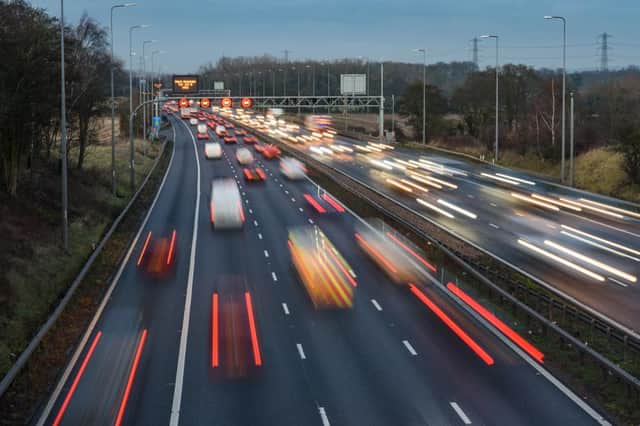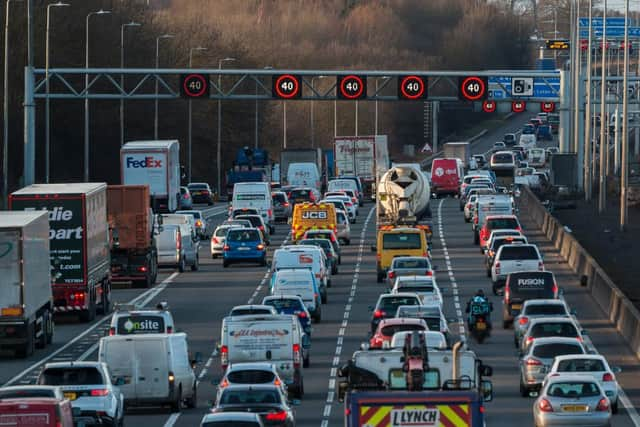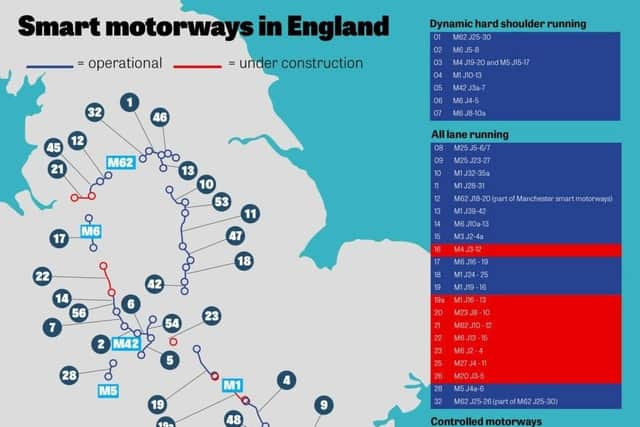Smart motorways UK: what are they, rules for using them, what to do if you break down - and fines for ignoring signs


A new study has found that less than half of UK drivers understand the rules of smart motorways.
Research by safety charity Brake and breakdown cover provider Green Flag revealed that just 48 per cent of motorists understood how to use the controversial roads correctly. While a further 27 per cent said they were aware of the roads but didn’t understand the rules, 25 per cent said they didn’t even know what a smart motorway was.
What are smart motorways?


Advertisement
Hide AdAdvertisement
Hide AdSmart motorways are designed to ease motorway congestion by permitting cars to be driven on the hard shoulder at least some of the time, with traffic monitored via cameras and sensors and controlled via active signs which can vary the speed limit and signal lane closures.
The idea is that smart motorways effectively add 33 per cent to motorway capacity for much less than it would cost in both financial and environmental terms to add a physical extra lane. But their safety has been questioned and many drivers are confused by the rules around them.
There are three types of smart motorway:
Controlled motorway with variable speed limits monitored via a regional traffic centre. You’re only allowed to use the hard shoulder in an emergency, for example a breakdown.


Hard shoulder running where vehicles can use the hard shoulder at peak times to ease congestion. The traffic control centre will put a speed-limit sign on the gantries above the shoulder to indicate it is in use, and a red X above it when it isn’t. Emergency refuge areas (ERAs) are positioned at intervals for vehicle breakdowns.
Advertisement
Hide AdAdvertisement
Hide AdAll lanes running. On these motorway stretches, the hard shoulder works as a normal lane all the time. Again, there are ERAs at regular intervals. The hard shoulder lane may be closed if there’s an incident. If this is the case a red X will be displayed above it on gantries.
Rules for using smart motorways
These rules, issued by Highways England, apply to all smart motorways.
Never drive in a lane closed by a red X signal. These are shown on overhead gantries.
Keep to the speed limits shown on the signs.
A hard shoulder is always identified by a solid white unbroken line – if there’s no speed limit displayed above it or a red X signal is displayed, do not use it except in an emergency.
A broken white line indicates a normal live lane.
Advertisement
Hide AdAdvertisement
Hide AdOn a motorway with no hard shoulder, use the emergency areas for emergencies. These are marked with blue signs featuring an orange SOS telephone symbol.
If your vehicle experiences difficulties, for example - warning light, exit the motorway immediately, if you can.
If you break down, put your hazard lights on.
What to do if you break down on a smart motorway
If your car develops a problem on the motorway but you can still drive it safely, the advice is to use the left-hand land and leave the motorway at the next available exit.
If you don’t think you will make it to the next exit and are on a smart motorway without a hard shoulder, put your hazard lights on and follow the orange SOS signs to the next emergency area. Use the phone there to call the authorities, this will give them your exact location.
Advertisement
Hide AdAdvertisement
Hide AdIf you can’t get off the motorway or to an emergency area you should move your vehicle as close as possible to the left-hand verge, boundary or slip road. If you feel you can get out safely, exit your vehicle via the left-hand door, and wait behind the safety barrier if there is one and it is safe to do so. Keep clear of your vehicle and moving traffic at all times. Call 999 immediately.
If your car stops unexpectedly in any lane and it is not safe to get out you should keep your seatbelts and hazard lights on and call 999 immediately. Highways England will close the lane and send assistance.
If there is a hard shoulder on a motorway, you can use it to stop in an emergency only. If you can, get behind the safety barrier and away from your vehicle and moving traffic. Use the nearest free SOS phone or call Highways England on 0300 123 5000 for help.
Do not put out a warning triangle in any circumstances.
Fines on smart motorways
The penalties on smart motorways are largely the same as any other motorway. Breaking the indicated speed limit will see you fined at least £100 and given three penalty points, with harsher punishment for more extreme incidents of speeding. Cameras used for enforcing variable speed limits are also in use when the national speed limit is in operation.
Advertisement
Hide AdAdvertisement
Hide AdIgnore a red X lane closed signal is illegal and if you are caught you will be fined. The standard fixed penalty is £100 and three points on your licence, although in some cases the matter could go to court and you could face more severe punishment.
Overhead gantry cameras can now detect cars ignoring red X warnings and automatically generate a fixed penalty notice.
Where are the UK’s smart motorways?
The latest data from Highways England shows there are 40 stretches of smart motorways across 12 roads in England, with eight more under construction:
M1: J6a-10; J10-13; J16-13; J19-16;J23a-24; J24 - 25; J25-28; J28-31; J32-35a; J39-42; J31-32
M3: J2-4a
M4: J3-12; J19-20
M5: J4a-6; J15-17
Advertisement
Hide AdAdvertisement
Hide AdM6: J2 - 4; J4-5; J5-8; J8-10a; J10a-11a J10a-13; J13-15; J16-19
M20: J3-5; J4-5; J5-7
M23: J8-10
M25: J2-3; J5-6/7; J7-10; J10-16; J16-23; J23-27; J27-30
M27: 4-11
M42: J3a-7; J7-9
M60: J8-18
M62: J10-12; J18-20; J25-26; J25-30; J28-29